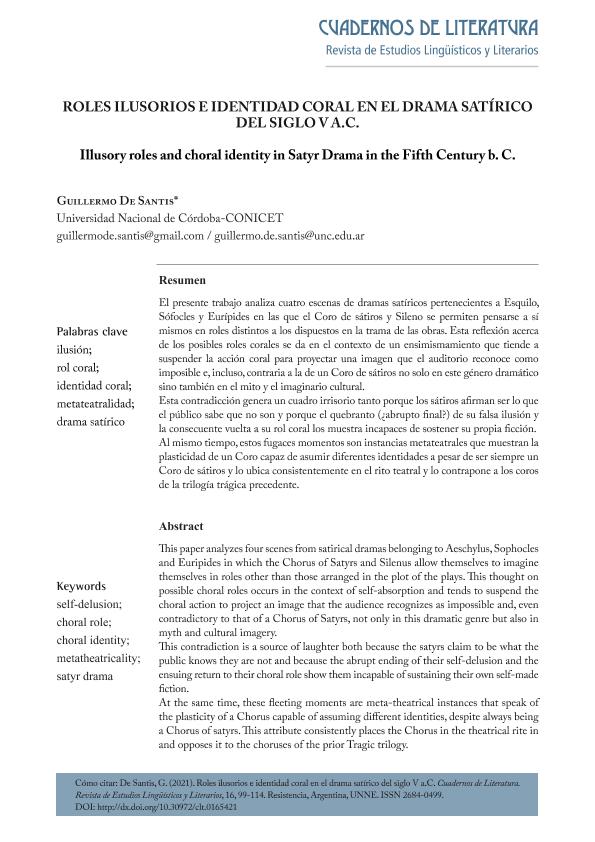Mostrar el registro sencillo del ítem
dc.contributor.author
de Santis, Guillermo

dc.date.available
2023-08-25T18:57:55Z
dc.date.issued
2021-06
dc.identifier.citation
de Santis, Guillermo; Roles ilusorios e identidad coral en el drama satírico del siglo V a.C.; Universidad Nacional del Nordeste. Facultad de Humanidades. Instituto de Letras; Cuadernos de Literatura; 16; 6-2021; 99-114
dc.identifier.issn
2684-0499
dc.identifier.uri
http://hdl.handle.net/11336/209429
dc.description.abstract
El presente trabajo analiza cuatro escenas de dramas satíricos pertenecientes a Esquilo, Sófocles y Eurípides en las que el Coro de sátiros y Sileno se permiten pensarse a sí mismos en roles distintos a los dispuestos en la trama de las obras. Esta reflexión acerca de los posibles roles corales se da en el contexto de un ensimismamiento que tiende a suspender la acción coral para proyectar una imagen que el auditorio reconoce como imposible e, incluso, contraria a la de un Coro de sátiros no solo en en este género dramático sino también en el mito y el imaginario cultural.Esta contradicción es generadora de risa tanto porque los sátiros dicen ser lo que el público sabe que no son y porque la ruptura de su ilusión y la vuelta a su rol coral los muestra incapaces de sostener su propia ficción.Al mismo tiempo, estos fugaces momentos son instancias metateatrales que hablan de la plasticidad de un Coro capaz de asumir diferentes identidades a pesar de ser siempre un Coro de sátiros, los ubica siempre en el rito teatral y lo contrapone a los coros de la trilogía trágica precedente.
dc.description.abstract
This paper analyzes four scenes from satirical dramas belonging to Aeschylus, Sophocles and Euripides in which the Chorus of Satyrs and Silenus allow themselves to imagine themselves in roles other than those arranged in the plot of the plays. This thought on possible choral roles occurs in the context of self-absorption and tends to suspend the choral action to project an image that the audience recognizes as impossible and, even contradictory to that of a Chorus of Satyrs, not only in this dramatic genre but also in myth and cultural imagery. This contradiction is a source of laughter both because the satyrs claim to be what the public knows they are not and because the abrupt ending of their self-delusion and the ensuing return to their choral role show them incapable of sustaining their own self-made fiction. At the same time, these fleeting moments are meta-theatrical instances that speak of the plasticity of a Chorus capable of assuming different identities, despite always being a Chorus of satyrs. This attribute consistently places the Chorus in the theatrical rite in and opposes it to the choruses of the prior Tragic trilogy
dc.format
application/pdf
dc.language.iso
spa
dc.publisher
Universidad Nacional del Nordeste. Facultad de Humanidades. Instituto de Letras
dc.rights
info:eu-repo/semantics/openAccess
dc.rights.uri
https://creativecommons.org/licenses/by-nc-sa/2.5/ar/
dc.subject
ILUSIÓN
dc.subject
ROL CORAL
dc.subject
IDENTIDAD CORAL
dc.subject
METATEATRALIDAD
dc.subject.classification
Literaturas Específicas

dc.subject.classification
Lengua y Literatura

dc.subject.classification
HUMANIDADES

dc.title
Roles ilusorios e identidad coral en el drama satírico del siglo V a.C.
dc.title
Illusory roles and choral identity in Satyr Drama in the Fifth Century b. C.
dc.type
info:eu-repo/semantics/article
dc.type
info:ar-repo/semantics/artículo
dc.type
info:eu-repo/semantics/publishedVersion
dc.date.updated
2023-06-28T15:46:35Z
dc.journal.number
16
dc.journal.pagination
99-114
dc.journal.pais
Argentina

dc.journal.ciudad
Resistencia
dc.description.fil
Fil: de Santis, Guillermo. Consejo Nacional de Investigaciones Científicas y Técnicas. Centro Científico Tecnológico Conicet - Córdoba. Centro de Investigaciones y Estudios sobre Cultura y Sociedad. Universidad Nacional de Córdoba. Centro de Investigaciones y Estudios sobre Cultura y Sociedad; Argentina
dc.journal.title
Cuadernos de Literatura
dc.relation.alternativeid
info:eu-repo/semantics/altIdentifier/url/https://revistas.unne.edu.ar/index.php/clt/article/view/5421
dc.relation.alternativeid
info:eu-repo/semantics/altIdentifier/doi/http://dx.doi.org/10.30972/clt.0165421
Archivos asociados
